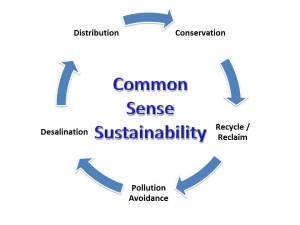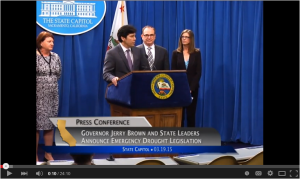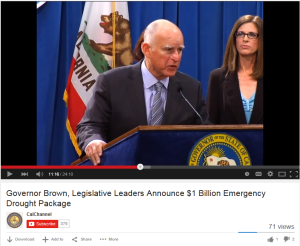By Terry Mullin, March 16, 2015
It’s about choices and common sense.
California is dry…and turning brown. Following on from my blog of January 5th, 2015 “What Have We Learned About the California Drought Since 2009”[i] it appears that the answer is “not as much as we should have.” California is still “on track” to build a high speed rail system for $68 billion. Many contend that the train has value – but there are other pressing issues that must be addressed as well. And since our state must live within its own budget, choices and priorities must be set.

California’s January was the driest ever since record-keeping began in 1895. The State’s groundwater and snowpack levels are at all-time lows. Data from NASA satellites show that the total amount of water stored in the Sacramento and San Joaquin river basins — that is, all of the snow, river and reservoir water, water in soils and groundwater combined — was 34 million acre-feet below normal in 2014. That loss is nearly 1.5 times the capacity of Lake Mead, America’s largest reservoir.[ii] Farmers have little choice but to pump more groundwater during droughts, especially when their surface water allocations have been slashed 80% to 100%. But these pumping rates are excessive and unsustainable. Wells are running dry. In some areas of the Central Valley, the land is sinking by one foot or more per year. Statewide, we’ve been dropping more than 12 million acre-feet of total water yearly since 2011. Roughly two-thirds of these losses are attributable to groundwater pumping for agricultural irrigation in the Central Valley[iii].
The time to act was actually before the year 2000 when in 2002 NASA data revealed that total water storage in California had been in steady decline since at least 2002, when satellite-based monitoring began, although groundwater depletion has been going on since the early 20th century.[iv]
We need to think in parallel steps to avoid a disaster.
First, the amount of water on our planet is finite, so we have to be prudent in its management and use. And it’s not just California; we have a world-wide water crisis that is only getting worse, so we must act locally, but think globally. That means that conservation, recycling/reclamation, pollution avoidance, desalination and distribution are key parts of the solution. We can’t keep marching on as a “tombstone society” – a society that only acts when it is too late. The time of procrastination has passed. Rationing is needed now to “buy time” to avoid a disaster. And we must work through the solutions – it is not a “one or the other” proposition – but rather an all in parallel approach. In this first part, we will be addressing water distribution.
Moving water from “A to B” – a water distribution challenge.
In this first part, we will be addressing the possible distribution issue. The knowns, short and to the point: California is in the worst drought in its history and we are in a very dangerous situation of running out of water. Other parts of the country, primarily east of the Mississippi, have experienced near record snow falls, not to mention that they have water access that the west simply does not have. So what if we address this as a nation-wide water management project?
One concept – build a “Keystone XL-like” pipe from the Midwest and East to the Central Valley of California to aid in alleviating the extreme drought situation. Using the Central Valley as a “distribution hub” for the water, other states would receive benefits as well. We have the infrastructure in that of lakes and reservoirs way below capacity, not to mention we could replenish our ground water tables. We could even expand storage – the technology exists. The Keystone XL was budgeted at $5.3 billion (which is 7.79% of the bullet train projected cost as of today[v]). What if a similar project could be completed to deliver water for the same price?
This Is Not Acceptable for the “8th Largest Economy in the World!”
California’s economy would be the 8th largest in the world (2012),[vi] if the states of the U.S. were compared directly with other countries.[vii][viii] As of 2013, the gross state product (GSP) is about $2.05 trillion, which is 13.2% of the United States gross domestic product (GDP)[ix]. And considering the size of the contribution that California makes to the economy and the nation’s produce/agriculture products, we simply can’t stand idly by and not act now.
What makes more jobs avoiding another “bust?”
Quoting the attached ABC News/AP article[x] by Scott Smith dated January 6, 2015 “California Breaks Ground on $68B Bullet Train, for 2029,” “project managers say design and planning already has created 632 jobs and that eventually 20,000 will work on the system.” And that is over the period of time of today through 2029, or 15 years. The included state report (referenced herein[xi]) states that the job creation could be up to 20,000 for the next five years. From there, “CONSTRUCTION JOBS AND MULTIPLIERS BY STEP, SPREAD OVER THE IMPLEMENTATION SCHEDULE” may lead to 66,000 for 15 years. But time will tell – for this part of the report, we will stick with the more generally accepted 20,000 projection.
Math and the ROI of a real water project.
So there is a choice in the making here: which is larger? 20,000 jobs or over 38 million Californians without water? And the water distribution system would carry significant employment as well, with longer-term positive results for not only California. It is quite simple…and once the project for the train is over, those 20,000 jobs disappear (except for pensions and follow-on infrastructure and operational costs). When 19 years is over, and way before it, we would have a water system to ensure the “moving” of water from East to West. And unlike the 20,000 that will be leaving the workforce, this system will help California and other states “balance the distribution” of water for years to come. Again, the choice appears clear.
So let’s spend $5.3 billion of the $68B to address the California water crisis.
The western drought. A drought that has no end in sight that is compounded by the inordinate amount of ground water California has been pumping out of its reserves. The western drought should also be looked upon as more of a severe “water distribution” challenge. Flooding in the mid-west and east, drought in the west. Seems like something American ingenuity and funding with a real ROI could address.
Through a proper nation-wide water distribution system, with appropriate storage at the receiving ends, before the flooding starts, you increase the capacity of the pumping to “stay ahead” of the situation. From the National Oceanic and Atmospheric Administration’s records, approximate $2,152,417,080 and 82 fatalities were attributed to flooding in 2013[xii]. This cost could be dramatically reduced and turned into “part of the water distribution solution” if the water was moved before it became “part of the problem.”
If monitoring shows that the supply could become greater than the demand and storage, we could build more storage and increase ground-water replenishment. I am not trying to over simplify the challenge, but our nation has conquered more daunting challenges – even eight years ago! And whereas we do not have a budget number for this hypothetical project, the need could justify nearly any cost. And considering the project would be moving water, not oil, should balance out the increased distance. In any event, spending on a project like this could provide a step in the right direction to alleviate the effects of the drought.
Build something with a minimal environmental risk.
Sometimes, from a riskier proposition, a common sense solution presents itself. As it turns out, pipelines are the safest and most efficient method of moving fossil fuels, and TransCanada has one of the best safety records in the industry.[xiii] Just ask the Canadians. There are more than 2.6 million miles of oil and natural gas pipelines in the United States that deliver 99.9998 per cent of their products safely and reliably every day. The State Department’s own environmental impact statement found that Keystone XL would operate with a degree of safety greater than any other pipeline in the U.S. But I’m not talking about pumping oil; I’m talking about moving water!
Show me the downside…we can already show you the money.
The Keystone XL Pipeline Project which was vetoed by the President in early 2015 was a proposed 1,179-mile (1,897 km), 36-inch-diameter crude oil pipeline, beginning in Hardisty, Alta., and extending south to Steele City, Neb. This pipeline was considered “a critical infrastructure project for the energy security of the United States and for strengthening the American economy[xiv].” I am not debating or endorsing the merits/risks of the Keystone – but I am referencing it as a demonstration of what technology and manpower can accomplish today. Just as improved water availability would strengthen the California and national economies.
We could enlist our Canadian friends or our own entrepreneurial American engineers and build a pipeline with a much greater degree of safety than any other in the U.S. This “Keystone XL-like” pipeline could run from the East and Midwest through the Central Valley of California and ultimately to Lake Mead (for storage) to alleviate the dire drought situation. Clearly, we could use the same ingenuity that built the Hoover Dam to accomplish this simpler task[xv] . Using the Central Valley as a “distribution hub” for the water, other states could receive benefits as well. The Central Valley is one of the world’s most productive agricultural regions[xvi]. After all, Lake Mead has room as it is at the lowest level since Hoover Dam was built in the 1930’s. [xvii] And Lake Mead has room, as of January 25th, 2015 Lake Mead’s level is 41.68% of “full pool” which is of great concern.[xviii]
Again, there are 2.6 million miles of oil and natural gas pipelines in the United States today, so adding water distribution pipelines is “not rocket science.”
Agriculture needs water.
Fiscally speaking, California leads all of the other states in farm income. It’s positioned as the agricultural powerhouse of the United States. About 73 percent of the state’s ag revenues are derived from crops while the other 27 percent of revenues are generated by livestock commodities. In terms of revenue generated, California’s top five ag products are dairy products, greenhouse and nursery products, grapes, almonds, and cattle and calves. California agriculture generates roughly $37.5 billion annually, more than any other state[xix]. But all of this is dependent upon water.
In food production, according to the latest statistics compiled by the California Department of Food and Agriculture[xx], the state produces almost half of all the fruits, nuts and vegetables grown in the country, as well as a whopping share of the livestock and dairy[xxi]. So I think we should be very concerned about it drying up into a dust-bowl and no longer being able to supply food.
But what if there is a leak?
Budgeted at $5.3 billion for the crude oil pipeline, with all of the challenges and complexities that would have accompanied it, it would seem that a water pipeline could be accomplished in this price range as well – and faster. The Keystone 36-inch diameter pipeline was specified to provide the capacity of 830,000 barrels of crude per day – that’s 26,145,000 gallons per day. And when you consider the high number of remote-controlled shutoff valves, increased pipeline inspections, burying the pipe deeper in the ground and using thicker steel pipe at river crossings, a water pipe does not pose as much of an environmental hazard[xxii] and in theory should be simpler to accomplish.
For the price, don’t install only one pipe.
When you consider the viscosity of crude oil over water, the cost of the water delivery system itself will be markedly less. Viscosity is the measurement of a fluid’s internal resistance to flow. This is typically designated in units of centipoise or poise but can be expressed in other acceptable measurements as well. Without getting into too much science, crude oil has a viscosity in the range of 10,000 centipoise[xxiii]. Water, by comparison has a viscosity of 1 centipoise[xxiv]. With more than one pipe, you have increased capacity, higher-availability (if you have to shut one pipe down, the others pick up the capacity) and can support pipeline maintenance without interruption of capacity. And finally, the construction of a water pipe is simpler than that of a pipeline to deliver thicker, more “aggressive” crude oil.
The chance of a significant “environmental disaster” from a water leak is low.
The proposed solution poses minimal risks. When you have an oil leak from a system carrying crude, you need to have specialists trained to shut off, contain, and clean up the resulting impact. With a water system suggested here, if a leak took place you could get a plumber to turn off the valves and mop up the water! (Humor is allowed – but the point is valid: the system does not pose significant environmental nor human risk anywhere close to the 2.6 million miles of gas and other pipelines under America’s cities).
If we could get 20% from east of the Mississippi…
In an op-ed published Thursday March 12, 2015 by the Los Angeles Times, Jay Famiglietti[xxv], a senior water scientist at the NASA Jet Propulsion Laboratory in California, painted a dire picture of the state’s water crisis. California, he writes, has lost around 12 million acre-feet of stored water every year since 2011. So let us address that. It is NOT the total solution, but a way to start to see if we can “make sense” of water distribution.
Using some simple flow rate calculations, California’s interconnected water system serves over 30 million people and irrigates over 5,680,000 acres (2,300,000 ha) of farmland[xxvi]. As the worlds and most controversial water system, it manages over 40,000,000 acre feet (49 km3) of water per year[xxvii]. That’s about 13,034,057,100,000 gallons per year. So for sake of analysis 20% of that would be 2,606,811,420,000 gallons (approximately 8 million acre feet) per year.
To get 2.6 trillion gallons of water per year would require getting 297,581,212.33 per hour. If the flow calculations are correct, using high-pressure (20 f/s) and 26.631’ in diameter pipe, in theory you could deliver 300 million gallons of water per hour[xxviii]. Of course all of this is dependent upon snow and rain seasons to supply the water. And when there is not enough from the excess of snow pack melt and rain, other sources such as Niagara Falls (398,142,000,000 gallons per year fall over the falls[xxix]) and the Great Lakes (6 quadrillion gallons[xxx]) could be considered[xxxi] if it was considered “excess” or available. Of course proper acquisition, delivery, pumping costs (electrical and manpower), storage and processing must be considered too as the water-season does not run all year long.
For example, California could request to take 0.04345% of the Great Lakes annually to address the 20% noted in this study. And these are just two sources – and I am not including snow melt and rain that goes to the Atlantic ocean or rivers. This is a demonstration of the thinking and initiative can deliver real results, and makes everyone think twice about pollution in every fresh water source.
But is this possible and wouldn’t it take 15 years?
The Hoover Dam in Nevada is considered “the 8th wonder of the world.” To think it was designed and built in 1935 in 4 years (5 years if you include the apparatus installation[xxxii]) is a testimonial to innovation and drive in America. This water pipeline is nowhere near as daunting a task, and it would reaffirm the “American ingenuity” that many feel we no longer have. Think about that…Hoover Dam was built eighty years ago and with the technology available then it only took four years to build. I think we should be able to do better.
Now some “doubting Thomases” may say this could not be done. Consider this – at the dam, the river was diverted around the damsite through four 50-foot diameter tunnels, two on each side of the river drilled through the canyon walls. The tunnels, with a total length of 15,946 feet, or about 3 miles, were excavated to 56 feet and lined with 3 feet (300,000 cubic yards) of concrete. The two tunnels could carry over 200,000 cubic feet – more than 1.5 million gallons – of water per second![xxxiii] That’s 5,400,000,000 gallons per hour…I was solving for only 297,581,212 gallons per hour, or 6% of the capacity of a technological marvel that was built in 1935!
So where does this leave us?
The California water crises can be solved by incorporating all of the means highlighted and more innovations to come. In my next segment, I will be addressing one example of “pollute less” that can make a dramatic difference in the pollution of water around the world.
It’s about choices and the future…it’s about our children and our children’s children…it’s about common sense.
To follow is the official “Creating Jobs Through High-Speed Rail”: http://www.hsr.ca.gov/docs/programs/small_business/Creating%20Jobs%20Through%20High-Speed%20Rail.pdf
[i] https://greenboxguys.wordpress.com/2015/01/05/what-have-we-learned-about-the-california-drought-since-2009/
[ii] http://www.latimes.com/opinion/op-ed/la-oe-famiglietti-drought-california-20150313-story.html
[iii] http://www.latimes.com/opinion/op-ed/la-oe-famiglietti-drought-california-20150313-story.html
[iv] http://www.latimes.com/opinion/op-ed/la-oe-famiglietti-drought-california-20150313-story.html
[v] http://www.foxnews.com/politics/2015/01/07/california-bullet-train-most-expensive-public-works-project-in-us-history/
[vi] Comparison between U.S. states and countries by GDP (nominal)
[vii] “Largest state GDPs in the United States – California Texas New York Florida”. EconPost.com. November 11, 2009. Retrieved March 9, 2010.
[viii] “California economy ranking among world economies”. EconPost.com. November 8, 2009. Retrieved March 9, 2010.
[ix] “Widespread But Slower Growth in 2013”. Bureau of Economic Analysis, U.S. Department of Labor. June 11, 2014. Retrieved June 11, 2014.
[x] http://abcnews.go.com/Politics/wireStory/california-breaks-ground-bullet-train-climate-solution-28039207
[xi] http://www.hsr.ca.gov/docs/programs/small_business/Creating%20Jobs%20Through%20High-Speed%20Rail.pdf
[xii] http://www.nws.noaa.gov/hic/
[xiii] http://keystone-xl.com/about/environmental-responsibility/
[xiv] http://keystone-xl.com/about/the-keystone-xl-oil-pipeline-project/
[xv] Simpler in terms of pumping high-temperature, much thicker crude oil vs. water
[xvi] http://en.wikipedia.org/wiki/Central_Valley_%28California%29#cite_note-every-2
[xvii] http://www.nbcnews.com/watch/nightly-news/lake-mead-reaches-record-low-water-levels-amid-ongoing-drought-320641091566
[xviii] http://lakemead.water-data.com/
[xix] http://westernfarmpress.com/tree-nuts/what-happens-if-us-loses-california-food-production
[xx] http://www.cdfa.ca.gov/statistics/
[xxi] http://www.latimes.com/food/dailydish/la-dd-calcook-california-its-whats-for-dinner-20140312-story.html
[xxii] http://keystone-xl.com/about/environmental-responsibility/
[xxiii] http://en.wikipedia.org/wiki/Oil_sands
[xxiv] http://www.vp-scientific.com/Viscosity_Tables.htm
[xxv] http://www.latimes.com/opinion/op-ed/la-oe-famiglietti-drought-california-20150313-story.html
[xxvi] http://en.wikipedia.org/wiki/Water_in_California
[xxvii] Jenkins, Marion W.; Lund, Jay R.; Howitt, Richard E.; Draper, Andrew J.; Msangi, Siwa M.; Tanaka, Stacy K.; Ritzema, Randall S.; Marques, Guilherme F. (2004). “Optimization of California’s Water Supply System: Results and Insights”. Journal of Water Resources Planning & Management 130 (4). pp. 271–280. doi:10.1061/(ASCE)0733-9496(2004)130:4(271).
[xxviii] http://www.1728.org/flowrate.htm
[xxix] http://www.niagarafallsstatepark.com/Amazing-Facts.aspx
[xxx] http://www.great-lakes.net/lakes/ref/lakefact.html
[xxxi] http://www.niagaraparks.com/about-niagara-falls/geology-facts-figures.html
[xxxii] http://www.usbr.gov/lc/hooverdam/faqs/damfaqs.html
[xxxiii] http://webcache.googleusercontent.com/search?q=cache:NU-IXObHIbkJ:www.usbr.gov/lc/region/pao/brochures/faq.html+&cd=1&hl=en&ct=clnk&gl=us
Reference for the California High Speed Rail project: http://www.hsr.ca.gov/docs/programs/small_business/Creating%20Jobs%20Through%20High-Speed%20Rail.pdf















